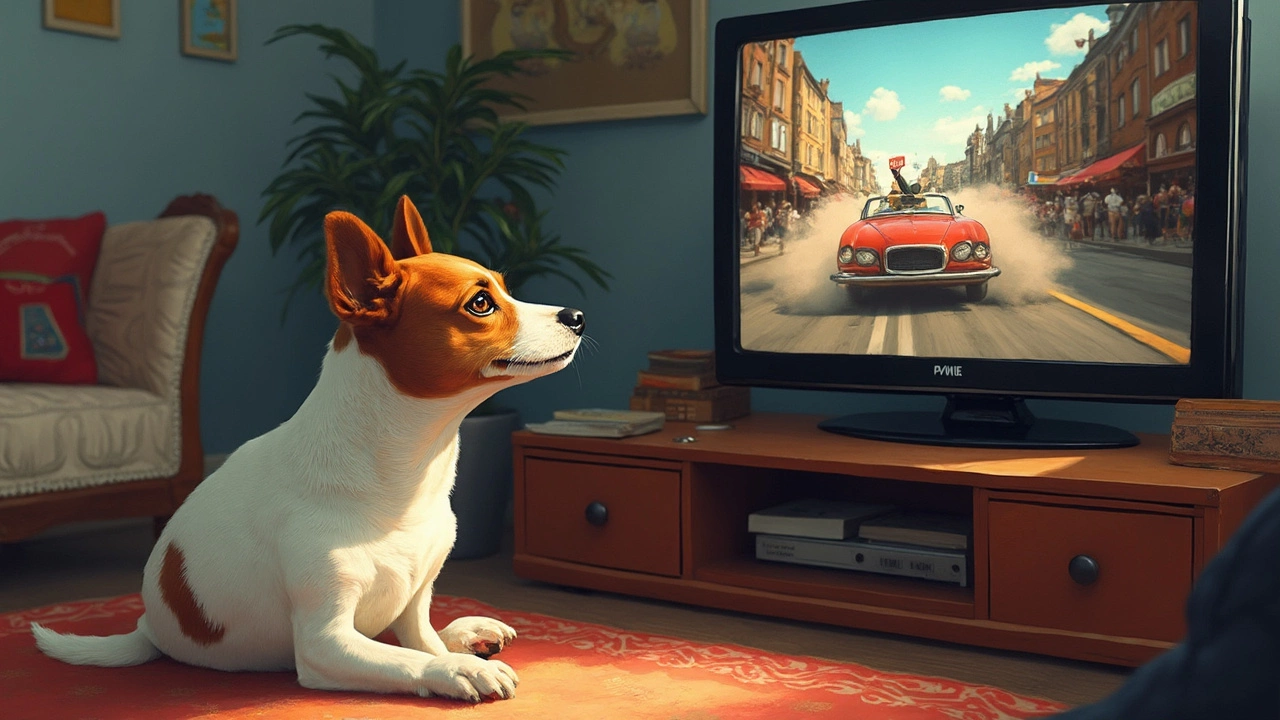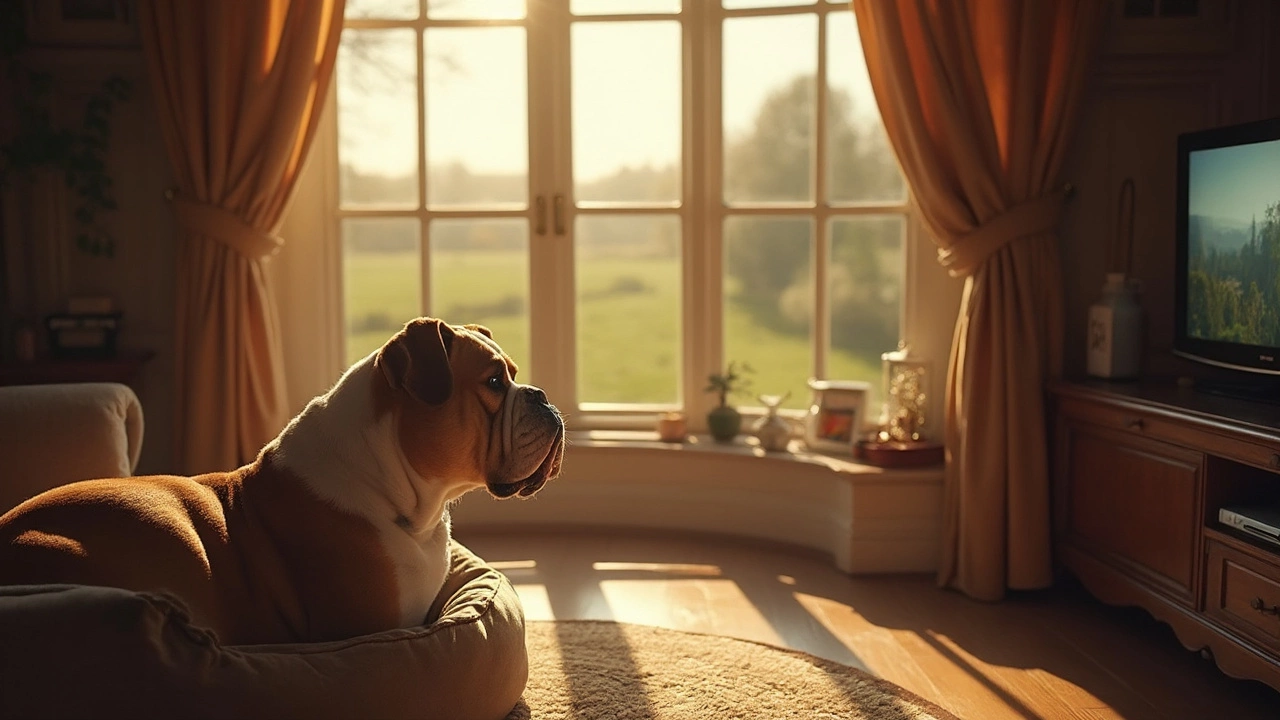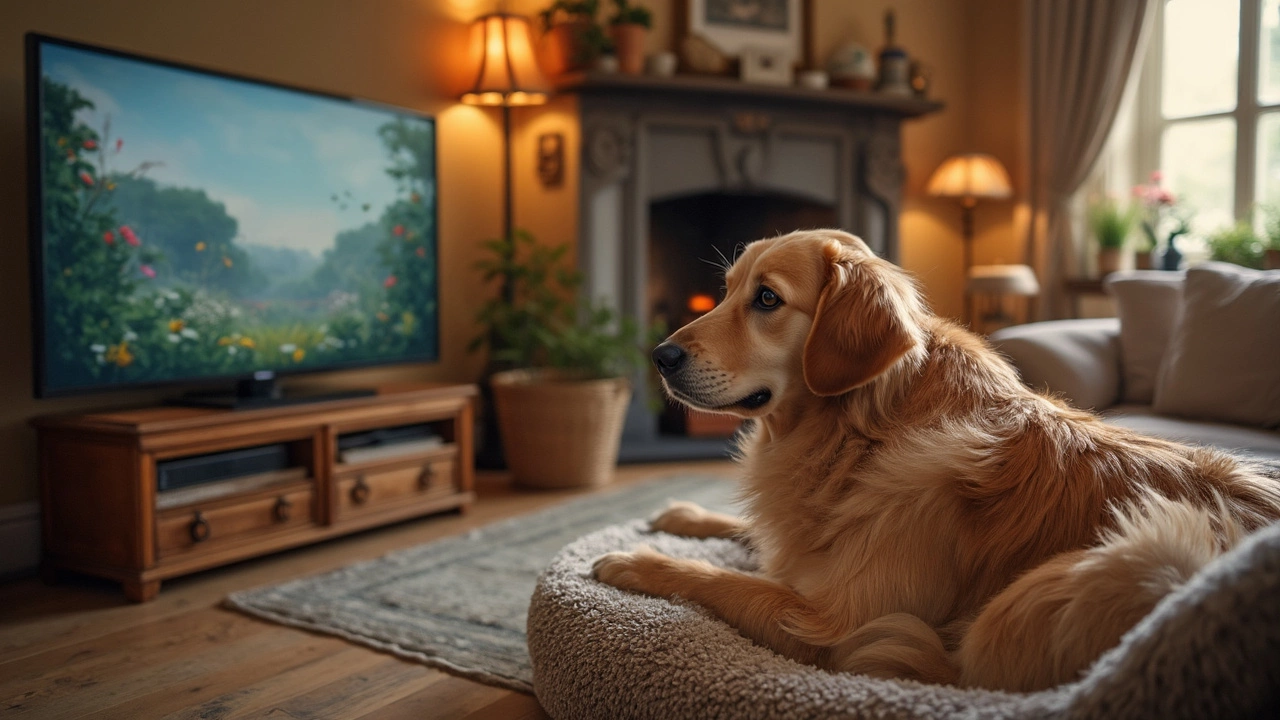So, you've probably caught your dog glancing at the TV screen or maybe even barking at it, right? You're not imagining things. Some dogs really react to what's happening on that big or small screen in your living room. But do they actually like it? That's a bit more complex.
Dogs see things differently than we do, literally. They have fewer color receptors, so they don't perceive vibrant shades like we do. But interestingly, they're more attuned to movement, which makes fast-paced action on TV quite attention-grabbing for them!
There's also the aspect of companionship. If you ever feel guilty about leaving your dog alone at home, here’s a fun tidbit: TV might serve as a bit of soothing background noise for them. It’s akin to white noise, creating a sense of normalcy while you’re away. Of course, every dog is different, and some might find it overstimulating.
- Dog Vision and TV
- When TV Helps with Separation
- The Role of TV in Dog Anxiety
- How Dogs Respond to Sounds
- Using TV Wisely for Your Dog
Dog Vision and TV
Ever found it weird that your dog seems totally lost in a TV show? Turns out, there's some science behind it! First things first, dogs don't see the world in the same color spectrum as we humans do. They primarily see shades of blue and yellow, which makes it hard for them to catch certain colors on the screen. But that's not the full story.
Movement and Flicker Rates
The real kicker is how dogs are super visual in detecting movement. While humans tend to view motion at around 60 Hz, dogs can detect quicker motion because they perceive flicker rates up to 75 Hz or more. This makes action-packed TV scenes quite interesting for them!
Dr. Susan Hazel, an expert in animal behavior, explains:
"Dogs are much more sensitive to motion than humans, thanks to their vision evolved for hunting. This sensitivity is why they often react actively to fast-moving images on TV, almost as if they're catching something in motion."
Why It's Fun for Them
So what does this mean for your pup's enjoyment factor? If the scenes are too slow, your dog might just snooze it off. But put on a show like an agility championship or something with quick movements, and you might find your pup more engaged.
But remember, not all dogs are TV aficionados. Some will wag their tails at cartoons, while others may just curl up and prefer the sounds that remind them of being in a busy, cozy environment.
- Dogs pick up on movement more than colors.
- TV shows with rapid movements are most engaging.
- Sound can also attract their attention.
Practical Tips
If you want your dog to enjoy some TV time, try content with lots of movement and less static. And notice how they react to different programs to figure out what they might like the most!
When TV Helps with Separation
Most dog owners have encountered the guilt trip when leaving their furry pals alone at home. Nobody wants to imagine their pup feeling lonely or anxious. But here's a practical tip: TV can sometimes be your ally in easing separation anxiety for dogs. Amazing, right?
Some dogs respond positively to the sounds and flickering of a TV. It mimics a sense of activity, which can be comforting. Think of it like leaving a light on when you don't want the room to feel empty. The same principle applies here.
How TV Relieves Separation Anxiety
Separation anxiety in dogs is a genuine issue. They can become vocal, destructive, or experience a lot of stress. Studies have shown that background noise like television can help provide a distraction. Certain channels even cater specifically to dogs, using content designed to be engaging yet calming for our four-legged friends.
- Alleviates Loneliness: When there's something happening on the screen, dogs might not feel so alone.
- Soothing Soundscapes: The right shows offer soothing sounds which can help keep them calm. Think nature sounds, like birds or ocean waves.
- Visual Engagement: Though they're not viewing TV the way we do, some dogs enjoy watching moving images.
Of course, it's essential to pair this with other anxiety-reducing techniques, like lots of exercises and interactive toys. Simply leaving the TV on isn’t a standalone solution but a piece of the puzzle.
Choosing the Right Content
Not all TV shows are created equal, at least in the eyes of a dog. If barking or loud noises are frequent, it could potentially add stress rather than reduce it. Opt for content with tranquil music, and natural visuals, or check out channels specifically for pets that are designed to keep them chill. It’s like choosing the right playlist for yoga versus a rock-out gym session!
Try different channels and observe your dog's behavior to figure out what they enjoy the most. Their response might be your guide to whether the TV should continue to be part of their alone-time routine.

The Role of TV in Dog Anxiety
Anxiety in dogs is like that unwanted guest that overstays its welcome. It can sneak up on a perfectly happy pup, and understanding how to manage it is key. Here’s where the TV can play a surprising role.
Not every dog gets calm by watching TV, but for those who do, it offers a distraction from stressors. Think about all those sounds and images – they're not just there for fun. They can engage a dog’s mind, especially when their humans are at work. This engagement can be crucial in reducing separation anxiety.
Background Noise vs. Real Life
Many dogs are comforted by the white noise effect that TV provides. Imagine it’s like the gentle hum of chatter that you might hear when surrounded by friends. It creates an illusion of company. The key is to find a channel with sounds that your dog is comfortable with, like nature shows or even programs designed specifically for dogs.
- Choose channels with calm, consistent soundtracks.
- Avoid programs with sudden loud noises or high-pitched sounds that might startle your pet.
Signs TV Helps Alleviate Anxiety
Wondering if your dog benefits? The proof is in their behavior. Look for these signs:
- Your dog seems more relaxed during and after TV time.
- There's less destructive behavior when you leave the TV on.
- Your dog starts to associate the TV with their cozy bed time.
Keep in mind, though, every dog has its own personality. Not every furry friend wants to be a couch potato watching TV – some might prefer other methods to ease anxiety.
Ultimately, the goal is to create an environment where your dog feels safe and at ease. Using TV strategically can be a part of the solution for anxiety. Play around with different options and see what works best for your pet’s unique needs.
How Dogs Respond to Sounds
If you're curious about how dogs react to sounds from the TV, you're not alone. Dogs have an incredible sense of hearing, far superior to ours. While humans hear frequencies up to 20,000 Hertz, dogs can catch sounds as high as 65,000 Hertz. Pretty impressive, right?
When you're watching TV, your dog might respond differently depending on several factors, such as the type of sound, volume, and their individual sensitivity.
Common Sounds and Your Dog's Reactions
Sounds like barking, animal noises, or the doorbell can trigger your dog’s instinctual reactions. It’s not unusual for dogs to bark back at the TV if they hear other dogs barking. They might see it as a call to arms or just a neighborhood chat. When it comes to loud noises like explosions or a thunderstorm on a TV show, some dogs might feel anxious or scared, similar to their reaction to fireworks.
Using TV Sounds for Training
You can actually use the TV as a training tool. To help prevent anxiety or nerves about certain sounds, playing them softly on TV can help desensitize your dog. Gradually increase the volume over time and reward them for staying calm. This could be great practice for helping them cope with real-life events.
Some shows even design content specifically with dogs in mind, using sounds and visuals that appeal to them more than typical human-centric TV programming.
Whether your dog finds the TV comforting or confusing, understanding their reactions can help you create a peaceful and supportive environment, complete with their favorite spot on their comfy dog beds.
| Sound Type | Common Reactions |
|---|---|
| Dog Barking | Barking or alerting |
| High-Pitched Noises | Curiosity or Whining |
| Loud Explosions | Anxious or hiding |

Using TV Wisely for Your Dog
So you’re thinking about putting on the TV while your dog is chilling on their dog bed. Great move! But there are smart ways to do it to make sure it actually benefits your furry buddy.
Choose the Right Shows
Not all TV shows are created equal when it comes to our four-legged friends. Look for channels or programs designed specifically for pets. These often feature nature sounds, wildlife scenes, or even fellow canines, which can be quite engaging. Stay away from loud action movies or intense dramas that might startle your pup.
Volume Matters
You know how jarring a too-loud TV can be, right? Well, the same goes for dogs. Keep the volume at a moderate level. This way, it acts more like gentle background noise that mimics the sounds of daily life, rather than blaring and stress-inducing noise.
Time It Right
TV shouldn't be on all the time. Use it during times when you’d like to keep your dog engaged, like when leaving them alone or during stressful events like thunderstorms. But remember, nothing beats human interaction, so ensure your dog gets plenty of face-time with you!
Monitor Their Reaction
Watch how your dog reacts to different programs. Are they more relaxed, or do certain images or sounds make them anxious? This can help you choose content that best keeps them chill. No point in keeping the TV on if it’s making your pup nervous or hyperactive.
Benefits to Consider
- Reduced Anxiety: Gentle sounds and visuals can soothe dogs with anxiety issues.
- Prevention of Loneliness: A TV can help your dog feel less isolated while you're out.
In short, using the TV wisely can be a useful tool in keeping your dog comfortable and content. Pair it with comfy dog beds and you've got a cozy setup that’s hard to beat!

